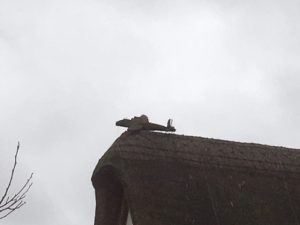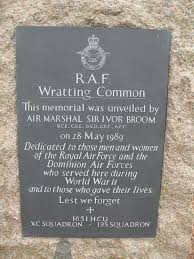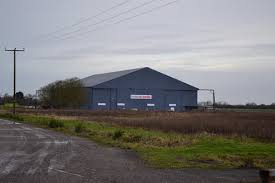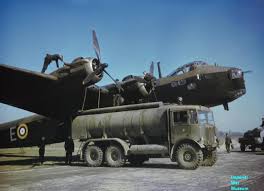Yes, thatch but not a thatched animal this time – ‘It’s thatch Jim but not as we know it”!
It’s a World War 2 thatched Short Stirling four engine heavy bomber. The first of the four engine heavies prior to the Lancaster and Halifax and the scourge of Nazi Germany. Its appearance on a barn roof in Little Thurlow is undoubtedly because of the nearby airfield at Wratting Common which flew the Stirling, along with its parent station at Stradishall (now HMP Highpoint). Many of the old war time building still remain at the site of the airfield including two large hangers and the local roads follow the course of the old runsways.
RAF Wratting Common was a Bomber Command airfield built comparatively late in the war (1942), and was operational from 1943 to 1945. It is situated between the villages of West Wickham, West Wratting, Carlton/Weston Colville and Withersfield, close to the Cambridgeshire border with Suffolk. For much of this period, approximately 1,500 personnel were stationed here.
In the early stages of its life the airfield was called RAF West Wickham. However it was renamed in August 1943 as RAF Wratting Common to avoid confusion with another similarly named RAF station, possibly High Wycombe (Bomber Command HQ).
The station hosted one squadron at a time, but during the war three different squadrons used the base. Between May and October 1943 it was the home to 90 (XC) Squadron, who flew Stirling bombers. XC Squadron then moved elsewhere and RAF Wratting Common became the home for 1651 Heavy Conversion Unit, a training Squadron for bomber crews. Then in November 1944 1651 RAF Wratting Common became the home to 195 Squadron, equipped with AVRO Lancaster bombers for an aggressive operational role. Many bombing missions over Germany were mounted from the base in the last months of the war.
In the closing days of the war, Lancasters from RAF Wratting Common took part in non-combat missions, notably operation MANNA in April/May 1945 in which the bombers were used to airdrop food to the starving Dutch. Later the unit took part in operation EXODUS, in which allied prisoners of war were returned home from previously occupied Europe.
In August 1945 195 Squadron was disbanded. The station was used for various air training tasks by Transport Command for another year or so. The last aircraft left the base in June 1946 and the land has since returned to its original, rural, use. Most of the site is part of Thurlow Estates, owned by the Vestey family.
During the war bomber losses in operations flown from Wratting Common totalled 43 of which 34 were Stirlings.
The Short Stirling was a British four-engined heavy bomber of the Second World War. It has the distinction of being the first four-engined bomber to be introduced into service with the Royal Air Force (RAF).
The Stirling was designed during the late 1930s by Short Brothers to conform with the requirements laid out in Air Ministry Specification B.12/36. Prior to this, the RAF had been primarily interested in developing increasingly capable twin-engined bombers but had been persuaded to investigate a prospective four-engined bomber as a result of promising foreign developments in the field. Out of the submissions made to the specification, Supermarine proposed the Type 317 which was viewed as the favourite, while Short’s submission, named the S.29, was selected as an alternative. When the preferred Type 317 had to be abandoned, the S.29, which later received the name Stirling, proceeded to production.
During early 1941, the Stirling entered squadron service. During its use as a bomber, pilots praised the type for its ability to out-turn enemy night fighters and its favourable handling characteristics, while the altitude ceiling was often a subject of criticism. The Stirling had a relatively brief operational career as a bomber before being relegated to second line duties from late 1943. This was due to the increasing availability of the more capable Handley Page Halifax and Avro Lancaster, which took over the strategic bombing of Germany. Decisions by the Air Ministry on certain performance requirements, such as to restrict the wingspan of the aircraft to 100 feet, had played a role in limiting the Stirling’s performance; these restrictive demands had not been placed upon the Halifax and Lancaster bombers.
During its later service, the Stirling was used for mining German ports; new and converted aircraft also flew as glider tugs and supply aircraft during the Allied invasion of Europe during 1944–1945. In the aftermath of the Second World War, the type was rapidly withdrawn from RAF service, having been replaced in the transport role by the Avro York, a derivative of the Lancaster that had previously displaced it from the bomber role. A handful of ex-military Stirlings were rebuilt for the civil market.






 My name is Paddy McKeown, I am a retired police officer (Detective Sergeant – Metropolitan Police), turned chimney sweep. I have completed training with ‘The Guild of Master Chimney Sweeps’, and Rod Tech UK (Power Sweeping).
My name is Paddy McKeown, I am a retired police officer (Detective Sergeant – Metropolitan Police), turned chimney sweep. I have completed training with ‘The Guild of Master Chimney Sweeps’, and Rod Tech UK (Power Sweeping).




Comments are closed.